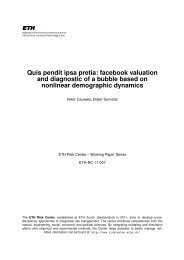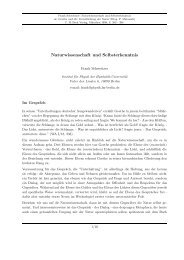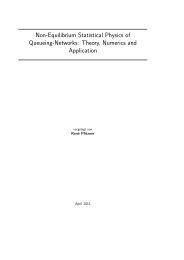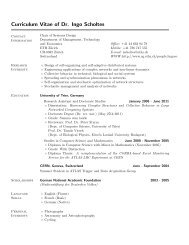Using Laboratory Experiments to Study Law and Crime - Chair of ...
Using Laboratory Experiments to Study Law and Crime - Chair of ...
Using Laboratory Experiments to Study Law and Crime - Chair of ...
You also want an ePaper? Increase the reach of your titles
YUMPU automatically turns print PDFs into web optimized ePapers that Google loves.
work. Despite this emphasis on experimental approaches, labora<strong>to</strong>ry experiments remain rare.In criminology we are typically interested in testing causal theories. Causal theoriesinclude two components – statements about causal relations <strong>and</strong> statements about causalmechanisms. A causal relation asserts that by varying one fac<strong>to</strong>r (X) we can affect another fac<strong>to</strong>r(Y). Mechanisms are the processes through which one variable influences the other (Hedström,2005; Horne <strong>and</strong> Hechter, 2009). <strong>Labora<strong>to</strong>ry</strong> experiments have unique strengths, not just inassessing causality (as field experiments do) but also in disentangling the mechanismsresponsible for causal relations. Thus they are valuable for testing causal theories.<strong>Labora<strong>to</strong>ry</strong> experiments are less useful for establishing the substantive importance <strong>of</strong>particular causal mechanisms <strong>and</strong> relations in the field. In other words, they are good for testingcausal theories, but not for studying properties <strong>of</strong> natural settings (Webster <strong>and</strong> Sell, 2007).<strong>Labora<strong>to</strong>ry</strong> experiments cannot tell us what the correlation is between disenfranchisement <strong>and</strong>recidivism in the United States (Manza <strong>and</strong> Uggen, 2006). But they can provide insightregarding the effects <strong>of</strong> exclusion from group leadership on obedience <strong>to</strong> the group’s rules.<strong>Labora<strong>to</strong>ry</strong> experiments cannot tell us how important a fac<strong>to</strong>r collective efficacy is forcontrolling crime in Chicago (or Seattle or Phoenix or Los Angeles) relative <strong>to</strong> other fac<strong>to</strong>rs(Sampson, Raudenbush, <strong>and</strong> Earls, 1997). But they can provide data showing that social supportfor sanctioning efforts affect levels <strong>of</strong> control in a group (Horne, 2009). <strong>Labora<strong>to</strong>ry</strong> experimentscannot tell us how much guards abuse prisoners or why particular people at Guantanamobehaved as they did. But they can show us how prison-like power structures can lead normalpeople <strong>to</strong> behave in abusive ways (Zimbardo, 2008).In sum, labora<strong>to</strong>ry experiments cannot tell us how substantively important particularcausal fac<strong>to</strong>rs <strong>and</strong> mechanisms are for predicting patterns in the field. They cannot tell us howmuch <strong>of</strong> the variance a particular causal fac<strong>to</strong>r explains in a substantive setting outside thelabora<strong>to</strong>ry. But they can help us <strong>to</strong> underst<strong>and</strong> the mechanisms that link a causal fac<strong>to</strong>r <strong>to</strong> anobserved outcome. They help us <strong>to</strong> underst<strong>and</strong> why we see the correlations we do. In otherwords, they increase our theoretical underst<strong>and</strong>ing. They increase (or decrease) our confidence3







